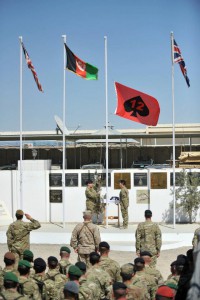12th April 2012 Harare, Zimbabwe
Injecting the civilian element into military training for Helmand
Transition in Helmand is not limited to Afghans taking the lead. Change is a constant factor for international civilians and military too.
Over the last month we have all been acutely aware of this transition known as the Relief in Place (RiP), where some of the outgoing and incoming soldiers are in theatre at the same time and different faces appear and queues for the cookhouse get longer. And today I witnessed my second Transfer of Authority (TOA) since taking up my Post in Helmand. I saw Brigadier Patrick Sanders, the outgoing Commander of Herrick 15, hand over to Brigadier Doug Chalmers of Herrick 16. This follows the TOA at Camp Leatherneck in March between US Marines Corps, myself and Michael O’Neill, the previous Head of Mission. 
But continuity is not lost. Brigadier Doug (first names are used) has been preparing for his role commanding 12 Brigade for 18 months. His tour will last 6 months so the training is a huge investment – but one which pays dividends.
Civilians play an important role in this continuity. The Stabilisation Unit, made up of the FCO, DFID & MOD civilians, now works with the army in supporting the military in their preparation. Alongside experienced PRT staff, I participated in the training exercises in the UK as well as joined the US marine equivalent exercise at Camp Pendleton in San Diego. The preparation is very sophisticated. The HQ is reproduced exactly as it will look in country – even down to where your phone will sit on your desk. This means people are very familiar with the work environment and can hit the ground running. And crucially our military counterparts form working relationships with us ahead of their deployment.
Scenarios are played out to prepare for all possible foreseeable events. For example, Brigadier Doug and I role played a visit of the Secretary of State for Defence – a visit that happened in reality on 28th March. Having been in Afghanistan now for 10 years the military have honed their training and preparation based on lessons on the ground of what works. Working effectively with civilian experts in one combined team is now seen as essential in counter insurgency campaigns. The lessons have been learnt and are now being applied.